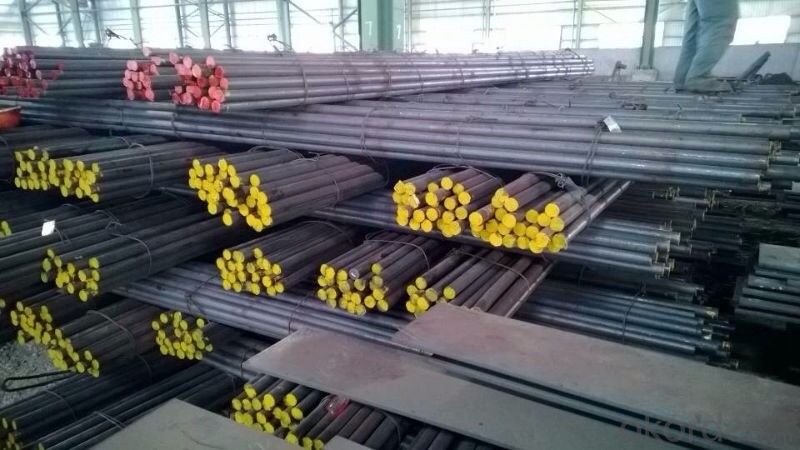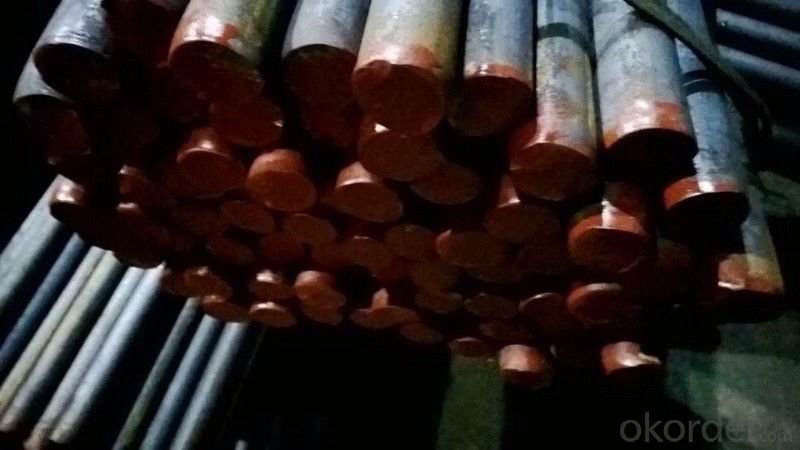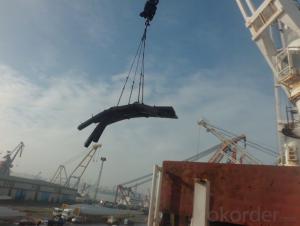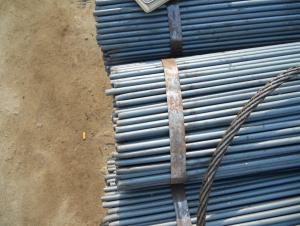Hot Rolled Round Carbon Steel Bar
- Loading Port:
- China Main Port
- Payment Terms:
- TT or LC
- Min Order Qty:
- -
- Supply Capability:
- -
OKorder Service Pledge
OKorder Financial Service
You Might Also Like
Product Description:
OKorder is offering Round Bar at great prices with worldwide shipping. Our supplier is a world-class manufacturer of steel, with our products utilized the world over. OKorder annually supplies products to European, North American and Asian markets. We provide quotations within 24 hours of receiving an inquiry and guarantee competitive prices.
Product Applications:
1. Hot rolled round bar of 6-25mm, or small round is mostly used for straight bundles supply, and used for steel, bolts and various mechanical parts. While the bigger round bar, or more than 25mm hot rolled bar, is mainly for the manufacture of mechanical parts or for seamless steel billet.
2. Besides, we can supply some especial material steel round bar that can be used for main shaft of steamer, hummer shank, with big section and supper force.
Product Advantages:
OKorder's Round Bar are durable, strong, and resist corrosion.
Main Product Features:
· Premium quality
· Prompt delivery & seaworthy packing (30 days after receiving deposit)
· Corrosion resistance
· Can be recycled and reused
· Mill test certification
· Professional Service
· Competitive pricing
Product Specifications:
1. Grade: Q195, Q235, Q345
2. Diameter: 6mm-150mm
3. Length: 6m, 9m, 12m or as customer’s request
4. Tolerance: Within ±5% for weight; ±2mm for diameter
5. Note: The price can be better is the quantity is good
6. Chemical composition
Alloy No | Element (%) | ||||
C | Mn | S | P | Si | |
Q195 | 0.06-0.12 | 0.25 | ≤0.05 | ≤0.045 | ≤0.3 |
Q235 | 0.12—0.20 | 0.3—0.7 | ≤0.045 | ≤0.045 | ≤0.3 |
Q345 | ≤0.2 | 1.00-1.60 | ≤0.045 | ≤0.045 | ≤0.55 |
Payment:
-Invoicing on theoretical weight or actual weight a s customer’s request.
-FOB, CFR or CIF.
-Regular terms of payment:
1, 30% payment in advance, the remaining balance (70% payment) against the copy of B/L.
2, 30% payment in advance, the remaining balance (70% L/C) against the copy of B/L.
3, Negotiable.
FAQ:
Q1: Why buy Materials & Equipment from OKorder.com?
A1: All products offered byOKorder.com are carefully selected from China's most reliable manufacturing enterprises. Through its ISO certifications, OKorder.com adheres to the highest standards and a commitment to supply chain safety and customer satisfaction.
Q2: How do we guarantee the quality of our products?
A2: We have established an advanced quality management system which conducts strict quality tests at every step, from raw materials to the final product. At the same time, we provide extensive follow-up service assurances as required.
Q3: How soon can we receive the product after purchase?
A3: Within three days of placing an order, we will begin production. The specific shipping date is dependent upon international and government factors, but is typically 7 to 10 workdays.
Q4: What makes stainless steel stainless?
A4: Stainless steel must contain at least 10.5 % chromium. It is this element that reacts with the oxygen in the air to form a complex chrome-oxide surface layer that is invisible but strong enough to prevent further oxygen from "staining" (rusting) the surface. Higher levels of chromium and the addition of other alloying elements such as nickel and molybdenum enhance this surface layer and improve the corrosion resistance of the stainless material.
Images:


- Q:Can steel round bars be used for making steering components?
- Yes, steel round bars can be used for making steering components. Steel round bars are known for their high strength and durability, making them suitable for applications that require a strong and reliable material. Steering components, such as tie rods or steering shafts, often require a sturdy material to withstand the forces and stresses associated with steering mechanisms. Steel round bars can provide the necessary strength and stability needed for these components, making them a suitable choice for steering system applications.
- Q:Can steel round bars be used for making automotive suspension systems?
- Yes, steel round bars can be used for making automotive suspension systems. Steel round bars are commonly used in the manufacturing of suspension components such as control arms, sway bars, and torsion bars due to their high strength, durability, and ability to withstand heavy loads and vibrations.
- Q:What are the different types of steel round bar alloys used in the construction industry?
- There are several different types of steel round bar alloys commonly used in the construction industry. Some of the most popular alloys include: 1. Carbon Steel: This is the most common type of steel alloy used in construction. It is known for its high strength and durability, making it suitable for a wide range of applications. 2. Stainless Steel: This alloy is highly resistant to corrosion and staining, making it ideal for construction projects where exposure to moisture or chemicals is a concern. It is often used in applications such as handrails, kitchen equipment, and structural components. 3. Alloy Steel: This type of steel contains additional alloying elements such as manganese, chromium, or nickel, which enhance its mechanical properties. Alloy steel round bars are known for their high tensile strength, toughness, and wear resistance, making them suitable for applications that require heavy-duty performance. 4. Tool Steel: As the name suggests, this alloy is specifically designed for making tools and machinery components. Tool steel round bars are known for their hardness, resistance to abrasion, and ability to retain their shape at high temperatures. They are commonly used in the construction industry for making cutting tools, dies, and molds. 5. Duplex Steel: This alloy combines the properties of both austenitic and ferritic stainless steels. Duplex steel round bars offer excellent corrosion resistance, high strength, and good weldability. They are often used in construction projects where a combination of strength and corrosion resistance is required, such as in marine or coastal environments. Overall, the choice of steel round bar alloy in the construction industry depends on the specific application and requirements of the project. Each alloy offers unique properties and advantages, allowing construction professionals to select the most suitable option for their needs.
- Q:How do you calculate the bending stress in a steel round bar?
- The bending stress in a steel round bar can be calculated using the formula: Bending Stress = (Moment * Radius) / (Section Modulus). The moment is calculated by multiplying the applied force by the distance from the force to the center of the bar. The radius is the radius of the round bar, and the section modulus is a property of the bar's cross-sectional shape that indicates its resistance to bending.
- Q:The difference between galvanized round bar and galvanized flat steel
- Galvanized round bar and galvanized flat steel are of different shapes and different uses.
- Q:What is the machinability of a steel round bar?
- The machinability of a steel round bar refers to how easily it can be shaped, cut, or formed using machining processes such as drilling, milling, or turning. It is influenced by factors such as the composition of the steel, its hardness, and the presence of impurities. Higher machinability indicates that the steel can be machined more efficiently and with less tool wear, while lower machinability may require slower cutting speeds or more frequent tool changes.
- Q:What are the different types of steel round bar surface finishes used in the aerospace industry?
- In the aerospace industry, there are several types of steel round bar surface finishes commonly used. These include: 1. Smooth Finish: This is a standard surface finish that is achieved through machining or grinding processes. It provides a smooth and polished surface, ensuring minimal friction and wear. 2. Brushed Finish: This finish is achieved by brushing the steel round bar with a fine abrasive material. It creates a distinctive linear pattern on the surface, enhancing its aesthetic appeal while maintaining a smooth texture. 3. Shot Blasted Finish: In this process, steel round bars are bombarded with small steel shots at high velocity. This results in a textured and slightly rough surface, which improves grip and provides better adhesion for coatings or paints. 4. Peened Finish: Peening involves impacting the surface of the steel round bar with small metal pellets or balls. This creates a dimpled texture, enhancing the material's resistance to fatigue and improving its strength and durability. 5. Anodized Finish: This is a surface treatment commonly used on aluminum alloys in the aerospace industry. However, it can also be applied to steel round bars. Anodization creates a thin, protective oxide layer on the surface, enhancing corrosion resistance and improving the material's appearance. These different types of surface finishes are chosen based on the specific requirements of the aerospace industry, considering factors such as durability, corrosion resistance, aesthetics, and functionality.
- Q:What is the difference between a bright and a rough turned steel round bar?
- A bright turned steel round bar and a rough turned steel round bar differ primarily in their surface finish and the level of precision involved in their manufacturing processes. A bright turned steel round bar has a smooth, shiny surface finish. This is achieved by subjecting the bar to additional processes such as polishing or grinding after the initial turning operation. The bright surface finish gives the bar an aesthetically pleasing appearance and can also provide improved corrosion resistance. On the other hand, a rough turned steel round bar has a more textured surface finish. It is typically obtained directly from the turning operation without any additional processes to refine the surface. The rough surface finish may have visible tool marks and a slightly uneven texture. In terms of manufacturing precision, a bright turned steel round bar is typically more accurate and precise in terms of its dimensions and tolerances. The additional processes involved in achieving a bright surface finish also allow for tighter control over the bar's specifications. This makes bright turned bars suitable for applications where precise dimensions and tolerances are critical. In contrast, a rough turned steel round bar may have slightly looser tolerances due to the nature of the turning process and the lack of additional refining operations. However, the rough turned bars can still meet the requirements of many applications that do not require high precision. Overall, the choice between a bright and a rough turned steel round bar will depend on the specific application and the desired surface finish and precision.
- Q:Are steel round bars suitable for use in the mining industry?
- The mining industry finds steel round bars to be suitable for use. These bars are renowned for their strength and durability, making them an ideal choice for heavy-duty equipment and machinery in mining. They can be utilized in various ways, such as shafts, support beams, and structural components in underground mines, open-pit mines, and processing plants. The steel round bars have the capability to withstand high loads and pressures, enabling them to thrive in harsh mining environments. They possess excellent tensile strength and can endure extreme temperatures, resulting in resistance to wear, abrasion, and impact. This is especially valuable in mining operations where equipment is subjected to heavy loads, vibrations, and constant movement. Furthermore, the steel round bars are easily weldable, fabricated, and machined to meet specific requirements, making them versatile and adaptable for a wide range of mining applications. They can be customized in terms of size, length, and shape, ensuring a perfect fit for various mining equipment and structures. Beyond their strength and versatility, steel round bars also offer cost-effectiveness and long-term value. They have a long lifespan, require minimal maintenance, and can withstand the harsh conditions typically encountered in mining operations, reducing the need for frequent replacements or repairs. Overall, steel round bars are a reliable and suitable choice for the mining industry due to their strength, durability, versatility, and cost-effectiveness. They provide the necessary support and structural integrity required for mining operations, ensuring the safety and efficiency of the industry.
- Q:How do steel round bars compare to fiberglass round bars?
- Steel round bars and fiberglass round bars have different properties and applications, making them suitable for various purposes. Steel round bars are known for their high strength and durability. They are commonly used in construction, manufacturing, and engineering industries, where strength and load-bearing capacity are crucial. Steel round bars can withstand heavy loads, making them ideal for structural applications such as beams, columns, and supports. Additionally, steel round bars have excellent resistance to impact, wear, and corrosion, making them suitable for outdoor and high-stress environments. On the other hand, fiberglass round bars offer unique advantages. Fiberglass is a lightweight and non-conductive material, making it suitable for applications where electrical conductivity or weight is a concern. Fiberglass round bars are commonly used in the electrical and telecommunications industries, where they provide insulation and safety. They are also resistant to corrosion, making them suitable for outdoor and marine applications. In terms of cost, steel round bars are generally more affordable compared to fiberglass round bars. Steel is a widely available material, and its production costs are relatively low. Fiberglass, on the other hand, requires specialized manufacturing processes and materials, which can increase its cost. Ultimately, the choice between steel and fiberglass round bars depends on the specific requirements of the application. If strength, durability, and load-bearing capacity are critical, steel round bars are an excellent choice. However, if weight, electrical insulation, or corrosion resistance are important considerations, fiberglass round bars may be more suitable.
1. Manufacturer Overview |
|
|---|---|
| Location | |
| Year Established | |
| Annual Output Value | |
| Main Markets | |
| Company Certifications | |
2. Manufacturer Certificates |
|
|---|---|
| a) Certification Name | |
| Range | |
| Reference | |
| Validity Period | |
3. Manufacturer Capability |
|
|---|---|
| a)Trade Capacity | |
| Nearest Port | |
| Export Percentage | |
| No.of Employees in Trade Department | |
| Language Spoken: | |
| b)Factory Information | |
| Factory Size: | |
| No. of Production Lines | |
| Contract Manufacturing | |
| Product Price Range | |
Send your message to us
Hot Rolled Round Carbon Steel Bar
- Loading Port:
- China Main Port
- Payment Terms:
- TT or LC
- Min Order Qty:
- -
- Supply Capability:
- -
OKorder Service Pledge
OKorder Financial Service
Similar products
New products
Hot products
Related keywords































